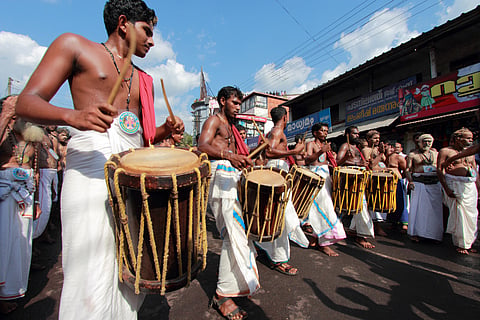
- Destinations
- Experiences
- Stay
- What's new
- Celebrating People
- Responsible Tourism
- CampaignsCampaigns
- Subscribe
- Buy Now

The quaint village of Peruvemba in Kerala is renowned for its deep-rooted tradition of crafting exquisite percussion instruments. For over 200 years, this village has been the heart of traditional instrument-making, supplying high-quality drums to temples, classical musicians, and folk artists across India. The skilled artisans of Peruvemba, who have inherited their craft from generations before them, are keepers of an invaluable musical heritage that continues to thrive in the face of modernisation.
The instruments made here are essential to Kerala’s rich musical traditions, particularly in temple festivals and classical performances like Kathakali and Theyyam. But their expertise is not just restricted to local classical dancers; their handicrafts are sought after by percussionists across the country.
Making these instruments is a meticulous task, requiring a deep understanding of acoustics, material selection, and assembly. Each drum is not just an instrument, but also a reflection of devotion and heritage, ensuring that the sound quality remains rich and resonant.
The village is known for producing some of Kerala’s most iconic percussion instruments, including:
Chenda: Perhaps the most famous instrument made in Peruvemba, the chenda is a cylindrical drum used in temple rituals, processions, and traditional dance performances like Kathakali and Theyyam. It is played using two sticks and is known for its powerful, rhythmic beats.
Maddalam: Another essential drum, the maddalam or madhalam, is a barrel-shaped instrument used in temple performances and traditional art forms. It is played with the hands and produces deep, resonant sounds.
Mridangam: A staple in Carnatic music, the mridangam is a double-headed drum played with both hands. Peruvemba’s artisans are known for their precision in crafting mridangams with superior tonal quality.
Edakka: A smaller, hourglass-shaped drum, the edakka or idakka is played with a stick and is primarily used in temple music and traditional performances.
Each instrument requires a deep understanding of materials, tuning, and assembly to achieve the desired sound quality.
Creating a percussion instrument in Peruvemba is a labour-intensive process that blends skill, patience, and tradition. The raw materials used—wood, animal skin, and metal—are carefully selected to ensure durability and sound perfection.
Wood Selection: The body of the drums is typically made from jackfruit, coconut, or mango wood, known for their ability to enhance sound quality.
Skin Preparation: The drumheads are made from buffalo or goat skin, which is treated and stretched to the desired tension.
Assembly and Tuning: The skin is fastened onto the wooden frame using leather straps or metal rings. Artisans carefully tune the drums by adjusting the tension, ensuring the instrument produces the right pitch and resonance.
Final Touches: Some instruments are adorned with intricate carvings or painted decorations before being polished and tested.
This entire process often takes weeks to complete.
Despite their mastery, the artisans of Peruvemba face several challenges in keeping their legacy alive. The advent of factory-made instruments has created stiff competition, often pushing traditional craftsmen to the sidelines. Besides, the younger generation is increasingly moving away from the trade due to economic constraints and the lack of recognition for handcrafted instruments.
The availability of raw materials has also become a pressing issue. Using animal skin has led to regulatory hurdles, and the increasing cost of quality wood makes production more expensive. Sustaining this traditional craft becomes difficult without proper government support and market demand.
Several initiatives are being taken to support the artisans of Peruvemba. Cultural organisations and music enthusiasts are advocating for the protection of this heritage by promoting handmade instruments. Workshops, government schemes, and direct collaborations with musicians have helped revive interest in handcrafted percussion instruments.
Tourism and cultural festivals also play a role in showcasing Peruvemba’s artistry. Music lovers and researchers visit the village to see the crafting process and interact with artisans, thus bringing awareness and appreciation for their craftsmanship.
